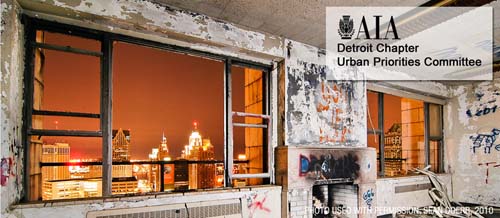I ascended the white marble steps of the Detroit Public Library in late May, invited to attend a symposium on “urban centers” in Detroit. I was expecting to find a group of seasoned professionals who shared strong opinions about a city they had only seen from an airplane or through the window of a taxi.
Instead, I encountered artistically minded people that included Kate Draughdrill, a young artist only weeks out of graduate school, and David Dixon, an experienced architect/urban planner from Boston and author of the New Orleans 2030 post-Katrina plan. Each person on the panels, which were moderated by Marja Winters, deputy director for the city of Detroit and co-project director for the Detroit Works Project, contributed to the discussion by sharing their experiences within the city, as well as by comparing and contrasting Detroit to similar cities across the country.
The architects, planners, and social activists offered advice and proposed simple actions that could be taken to improve Detroit’s situation. Dixon, part of the Massachusetts-based firm Goody Clancy, focused his keynote speech as well as his panel points on what he called “the age of the walkscore.” Claiming that downtowns are more important than anything, he asserted that the young college-educated individuals who are moving into urban environments today want diversity and walkability in their living space.
“It is downtown where the innovation happens … places to walk to that bring folks together are the real value,” says Dixon, adding that urban neighborhoods need a strong downtown core to be viable.
Philip McKenna, principal of McKenna Associates, an architectural and planning firm in Northville, set forth a series of rules for building an urban center. These included defining an area with a plan, creating legal management so that continuity is established, having a busy intersection(s), and establishing density.
One of the recurrent topics: How to bring younger generations into the city. Reed Kroloff, director of the Cranbrook Academy of Art in Bloomfield Hills, noted, “one little project moving forward is worth fifteen plans to the community.” And it is these bottoms-up productions that have been creating tangible improvements in Detroit communities.
Gina Reichert, co-founder of the art gallery Design 99 as well as the non-profit Powerhouse Productions, says urban cores are overemphasized, pointing out that Detroit is a neighborhood-centric city. After moving into a Detroit neighborhood near Hamtramck, she and her collaborator/husband began to not only rehab the existing houses they bought into independently sustainable homes, but worked with government officials to ensure that vacant houses in the area were safely and securely boarded up. Inviting other artists from all over the country to come and stay in the neighborhood, the houses soon transformed into pieces of art, protected from vandals by plywood sculptures and unique paint schemes.
According to Reichert, the houses themselves are producing something of value. However, Reichert made it clear that “We really aren’t an ‘urban center’…the strength of Detroit is the neighborhoods themselves.” Perhaps the answers to the city’s problems do not lie in centering activity in busy areas surrounded by urban farms, but can be found in decentralizing the city into its neighborhoods.
Reichert was not alone in her efforts to focus change on small-scale communities. Draughdrill, a New Orleans native who resides in Detroit, chose to start an organization named Detroit SOUP, which holds quarterly, $5 meals with all proceeds going to microgrants to support local creative projects voted on by the dinner guests. In addition, as part of her senior thesis, she gained access to friend’s Detroit garage and converted it into a space in which people could hold discussions about what needs to be done to better the city. Entitled “The Garage Sessions,” Draughdrill based the project on “deliberating spaces in a critical way,” or more precisely, “how a temporary gathering can function as a hub in an urban setting.”
Panel member Dan Kinkead, an architect at Hamilton Anderson Associates in Detroit, continually reiterated that whatever is in store for Detroit, the plans must be relevant to what the city embodies. As it stands, Detroit is seemingly being rebuilt by a dedicated group of self-motivated people who care about their city and are willing to move beyond discussion and take matters into their own hands.
Doug Voight, SOM director of Urban Design in Chicago, believes Detroit embodies an entrepreneurial spirit. The real entrepreneurs are urban pioneers who are starting a local garden plot, or creating safe places for the city’s youth, or providing the means for out-of-town artists to establish themselves. They are embarking on new, self-made enterprises that may not be making headline news, but are certainly resonating within the tight-knit communities found throughout Detroit.
And with the mess of red tape currently wrapped around City Hall, perhaps this is the solution to produce real change. As an aspiring architect, and purely as a born-and-bred metro Detroiter, I left the symposium with an ever-increasing feeling of hope. There are people are out there, seemingly overshadowed by the ruination, slowly salvaging the city piece by piece. How could one not be inspired?
So, bottoms-up, Detroit. Let’s all gain an internal perspective, and ask not what our community can do for us, but what we can do for our community.












